Triton is surprisingly similar to Pluto. Although the two may appear quite different, they have nearly identical sizes and compositions.
In 2022, the China National Space Administration (CNSA) announced plans to send a spacecraft to Neptune, expected around 2024. Upon arrival, it will become the second artificial vehicle ever to visit the Solar System’s “blue planet.”
Neptune does not resemble Earth in any way; the blue on our planet comes from oceans, while on this planet, the blue is due to its status as a massive ice giant with a turquoise hue and continuous raging storms.
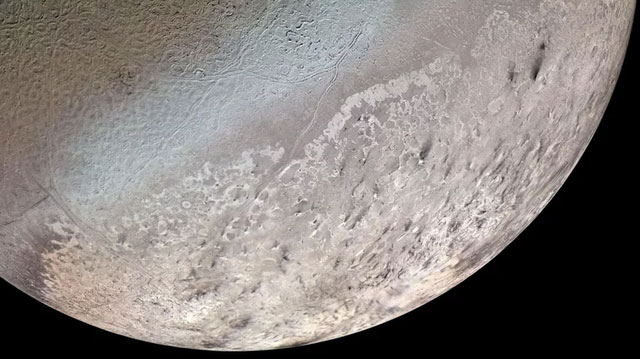
Triton is perhaps one of the most overlooked places in the entire Solar System.
Since Voyager 2’s flyby in 1989 provided a captivating glimpse of this icy world, scientists have continually sought more opportunities to explore the mysteries surrounding it. Unfortunately, despite all the plans and proposals, no NASA space missions to Neptune have been carried out to date. However, surrounding this planet is something even more intriguing than Neptune itself—its moon, Triton.
Triton is likely one of the most overlooked locations in the entire Solar System, having gone decades before it was named. The discovery of this moon was first reported in 1847 by the Monthly Notices of the Royal Astronomical Society, but at that time, it was still unnamed until 1880 in the book Astronomie Populaire.
As noted in the Encyclopedia of the Solar System, Voyager 2’s brief visit revealed only about 40% of Triton’s surface. The rest of this moon remains a mystery to us—one of the most enigmatic places in the entire Solar System—and naturally, the more mysterious something is, the more it attracts interest.
Pluto’s Sibling?
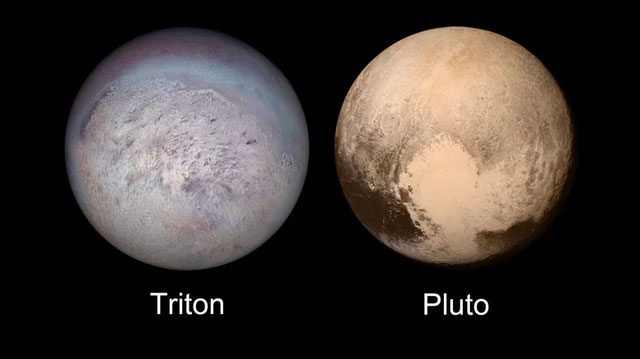
Triton’s moon surprisingly resembles Pluto.
According to NASA, Triton is the only satellite in the Solar System that orbits in the opposite direction to its parent planet. Its surface is also quite complex, featuring relatively flat plains interspersed with deep, pit-like surfaces.
These characteristics suggest that it did not form naturally around Neptune. As NASA explains, the prevailing theory is that Triton is a “captured” object from the Kuiper Belt—a collection of icy bodies in the Solar System extending from the orbit of Neptune to 44 AU from the Sun.
Furthermore, there is much astronomical evidence indicating that Triton surprisingly resembles Pluto. Although the two may appear quite different, they share nearly identical sizes and compositions. This suggests that they may have originated from the same place—in the cold darkness beyond Neptune’s orbit.
Many theories suggest that in the distant past, Triton’s original orbit passed by Neptune (similar to Pluto’s orbit) until it came too close and was captured by Neptune’s gravity. Neptune may have once had its own moons, but some may have been destroyed when Triton collided with them.
Volcanic Activity of Ice
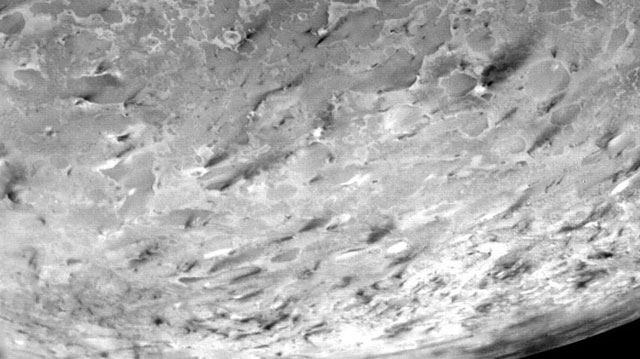
In a world far from the Sun like Triton, water would freeze and harden to the point that it behaves like tectonic plates on Earth.
According to NASA, as Earth’s tectonic plates move, volcanoes erupt molten rock; similarly, on Triton, there are cryovolcanoes (ice volcanoes) that erupt water instead of lava.
As explained in a paper from the Lunar and Planetary Science Conference, Triton’s surface appears to have volcanic terrain, with smooth lava flows, solidified remnants of lava lakes, and collapsed lava tubes, although some signs of past volcanic eruptions remain observable.
However, Triton’s “lava” is very different from liquid water on our planet; it is much denser and more viscous. It appears to be a mixture of water and ammonia, erupting as a form of icy snow.
Voyager 2 even captured images of a geyser erupting as it sped past this moon. This makes Triton one of the few locations in the entire Solar System known to have active volcanism—along with Earth, Venus, Jupiter’s moon Io, and Saturn’s moon Titan.
Triton Also Has Seasonal Weather
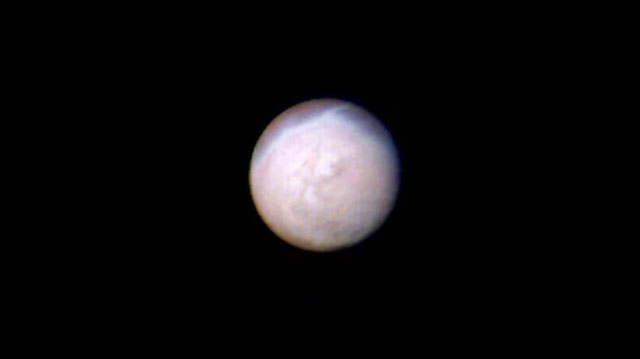
Triton also has an atmosphere covering its frozen surface.
Titan, Saturn’s massive moon, is famous for its thick, hazy atmosphere, but it is not the only moon in the Solar System with an atmospheric veil. Triton also has an atmosphere covering its frozen surface, though it is extremely thin compared to Titan, Earth, or even Mars.
Surprisingly, as a study in the journal Astronomy & Astrophysics explains, while Triton’s atmosphere may contain a convective layer—where weather can occur—it is not entirely like that on Earth.
The weather on Triton is surprisingly complex. As an article on Space explains, there are signs that Triton experiences seasons. In summer, Triton’s atmosphere thickens as its surface warms and gases begin to evaporate, while in winter, snow can even fall from the moon’s cold sky. Unlike on Earth, the snow on Triton is likely made from a mixture of nitrogen, methane, and carbon monoxide. And being so far from the Sun, transported by Neptune’s slow orbit, the seasons on this moon last a long time. Each summer and winter there can last 40 Earth years.
Auroras Illuminate Triton’s Night Sky

Triton’s auroras are similar to those on our planet. (Illustration).
The polar regions on Earth are known for their spectacular auroras that light up the night sky. As Discover Magazine explains, auroras are formed by charged particles from the solar wind. When these energetic particles collide with the atmosphere, they excite molecules, creating the beautiful light familiar to anyone living in polar regions.
But Earth is not the only place in the Solar System with auroras lighting up the sky. Astronomers have detected auroras on every planet except Mercury—due to the lack of an atmosphere. However, the discovery of auroras on Triton has surprised many.
The Washington Post published an article in 1989, shortly after Voyager 2 visited Neptune, explaining how both Neptune and Triton display auroras in their skies. Scientists were so astonished by what they observed that they initially hesitated to call it an aurora.
Auroras are usually caused by a planet’s magnetic field pulling in solar wind particles, but in the case of Triton, it seems to be due to the moon’s orbit around Neptune’s magnetic field, with charged particles on this moon being swept up by Neptune’s magnetism. With an atmosphere rich in hydrogen, Neptune’s auroras are likely to appear red, but Triton’s atmosphere is primarily nitrogen, similar to Earth. This means that Triton’s auroras would be similar to those on our planet.
Possible Subsurface Oceans
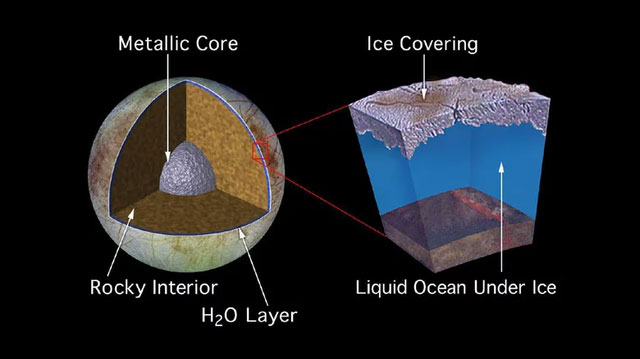
Triton is a top candidate in the search for one of the hidden oceans.
The giant planets beyond the Solar System often carry many icy moons, and many suspect that some of these satellites may be hiding subsurface oceans beneath their thick icy shells. As NASA notes, Jupiter’s moon Europa may even contain twice the amount of water found on Earth’s surface.
Composed largely of ice, Triton is a prime candidate in the search for one of these secret oceans. As noted by Scientific American, it is a particularly promising target with its cryovolcanoes and tectonic activity. The heart of Triton likely contains a significant heat source, helping to keep its interior from freezing.
Triton has an axial tilt of about 30 degrees, which means that as it orbits Neptune, the gravitational pull of the giant planet affects this moon, generating friction that warms it up. Another factor mentioned by Space is the fact that Triton’s core is made of rock. Similar to Earth, this rock is filled with heavy elements, including radioactive isotopes. As they decay, they release a considerable amount of energy in the form of heat, causing an effect known as radiogenic heating. These processes could even warm Triton’s ocean through hydrothermal vents, much like those found on the ocean floor of Earth.





















































